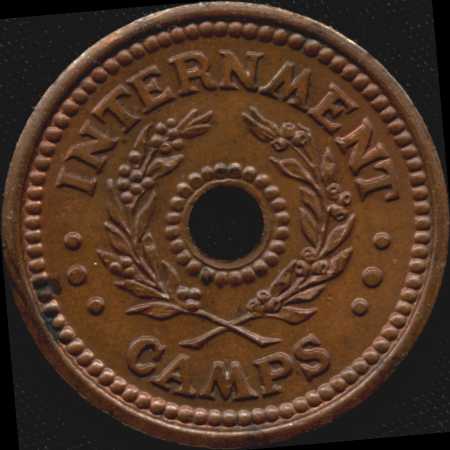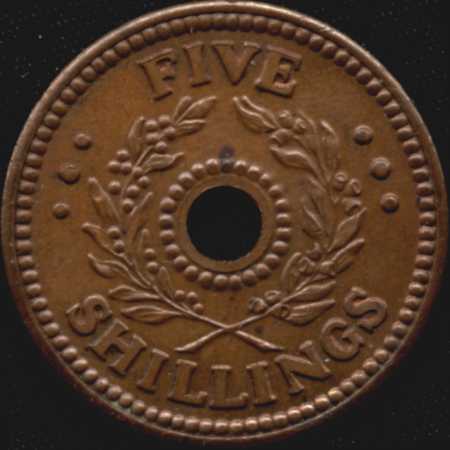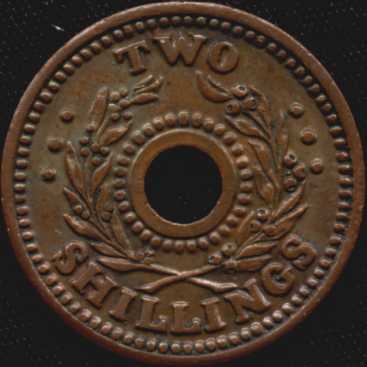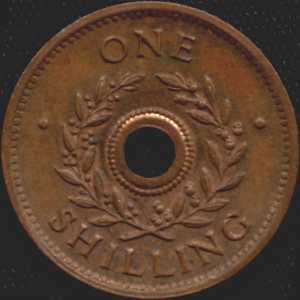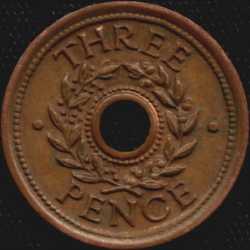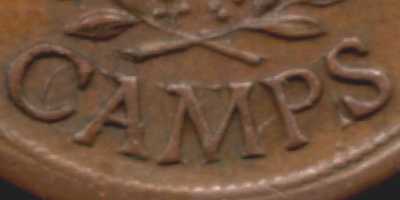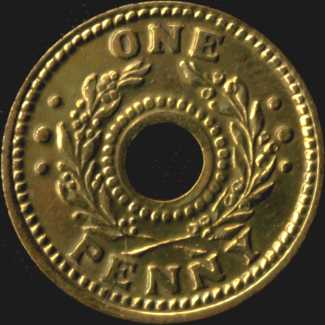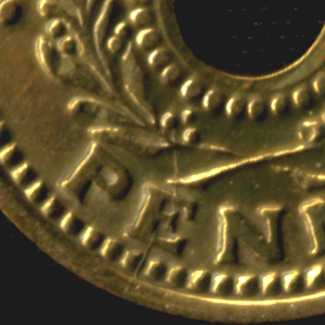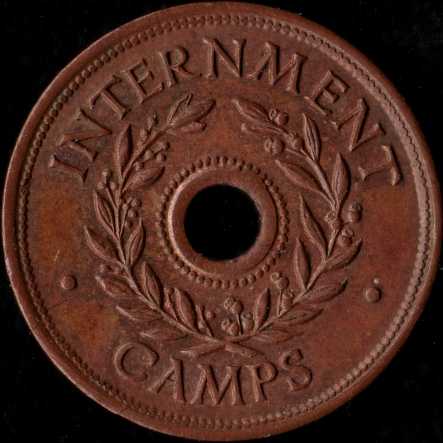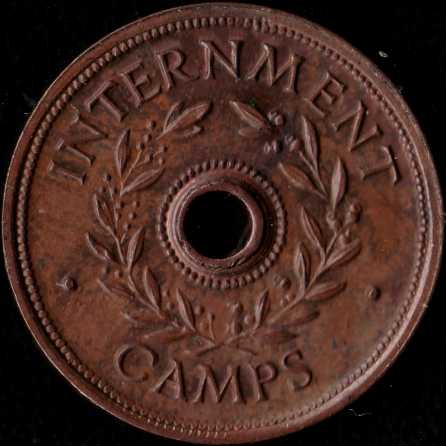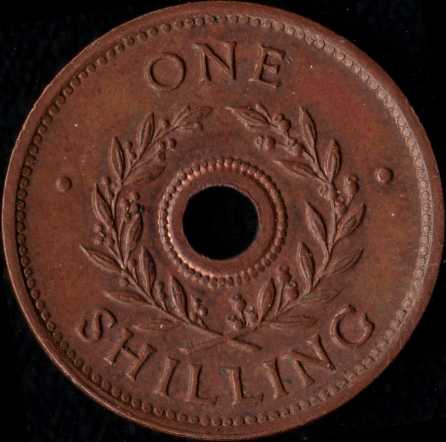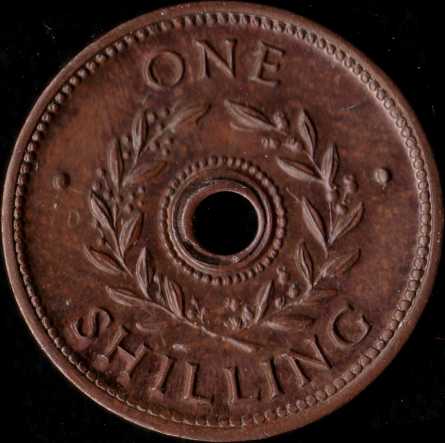The coinage of the Internment Camps
|
News, May 2002: NZ collectors discover
WWII internment camp token varieties
Liverpool, NSW, 1914-1917
The first internment camp for political prisoners was established at Liverpool
in New South Wales at the outbreak of World War I. Little is known about this camp
but it is of numismatic interest because the first Australian internment camp tokens
were issued for use there. Perhaps setting a precedent for the WWII camps, the Liverpool
token was radically different from any coin in general circulation.
Liverpool Internment Camp Token
7/10" across, this threepenny token is one of three types known for the
Liverpool camp. Not intended for long-term use, it was struck in aluminium. Very
few have survived and most of those are badly worn. This specimen would grade VF
or perhaps gVF. It was purchased from Downies.

|
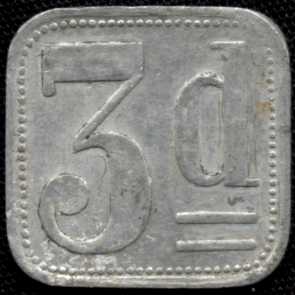
|
Hay, NSW, 1941-1945
It is fairly well known that Australia was "host" to a number of political
detainees exported from Britain in 1940 aboard the military transport ship Dunera.
The British Government considered these people to be potential spies but they
had not actually been convicted of any crime. Almost two thousand of these prisoners
were held at two camps near Hay in New South Wales where they remained until the
end of WWII.
Australian currency was prohibited inside the camps and the first medium of exchange
used therein was a series of currency notes produced inside the camp in 1941. The
denominations printed were 6d, 1/- and 2/- but the issue of these notes contravened
Australian law and they were withdrawn in favour of tokens issued by and on behalf
of the Australian Defence Canteen Service from September 1941 onwards. The Internment
Camp Tokens were struck by private contractors in Victoria and were also used in
New Zealand. They were withdrawn at the end of the war and exchanged for Australian
legal tender coins and notes. Nevertheless a few were souvenired by the inmates
and/or guards and so are available to collectors today. The 5/- token is by far
the scarcest and estimates put the number in existence below 100 specimens. This
means they are much rarer than the 1930 penny.
Reverses
|
The 5/- Hay Internment Camp Token. Minted by R. Arendeen & Sons Pty Ltd of Malvern,
Victoria.
Bronze, 28.6mm (roughly 1 1/8")
|
|
The 2/- Hay Internment Camp Token. Minted by R. Arendeen & Sons Pty Ltd of Malvern,
Victoria.
Bronze, 22.8mm (roughly 7/8")
|
|
The 1/- Hay Internment Camp Token. Minted by K. J. Luke & Co. Ltd of Fitzroy,
Victoria.
Bronze, 18.8mm (almost 3/4"), 2.25g - 2.4g
Note that the coins minted by Luke & Co show several differences in design
from the coins minted by Arendeen & Sons.
|
|
The 3d Hay Internment Camp Token. Minted by K. J. Luke & Co. Ltd of Fitzroy,
Victoria.
Bronze, 15.8mm (about 5/8"), about 1.35g
The word CAMPS on the obverse was originally engraved as CAMP and most specimens
of this coin show traces of the original lettering. It is possible that a few specimens
exist with the CAMP legend.
|
|
The 1d Hay Internment Camp Token. Minted by R. Arendeen & Sons Pty Ltd of Malvern,
Victoria
Brass, 20.3mm (about 13/16")
Note the reversion to the more ornate design and heavier lettering characteristic
of the Aberdeen & Sons tokens.
The specimen shown here has a die crack through the E in PENNY.
|
May 2002: ICT varieties discovered
New Zealand collectors Martin McKenzie and Rob Watts have discovered that there
are at least two reverse die varieties in the Hay 3d ICT. Martin sent me pictures.
Subsequently, I examined the tokens in my own collection and found that I had two
1/- tokens with different obverses and reverses.
Martin and Rob's discovery may be new. I have not seen any mention of this in
the numismatic literature.
Variations
Threepence
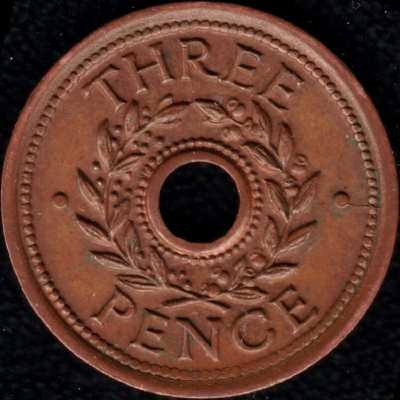
|
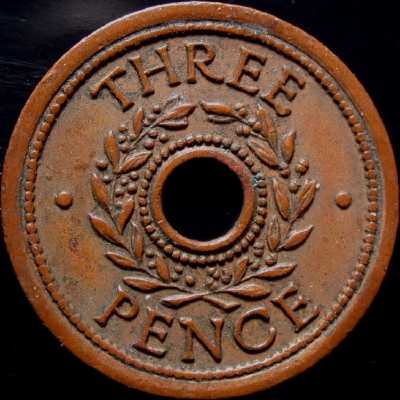
|
|
These are the pictures sent to me by Martin McKenzie to support his discovery of
the die variations in the Internment Camp threepence tokens. The number and positions
of the berries in the left branch are clearly different and the gumnuts in the right
branch are much larger on the second coin than those on the first.
The two reverses have the same number of beads on the inner and outer rims (47
and 111 respectively).
|
3d ICT enlargements
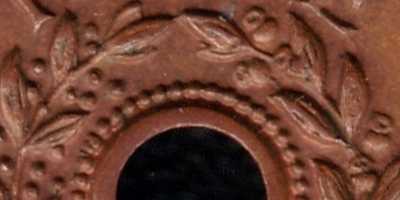
|
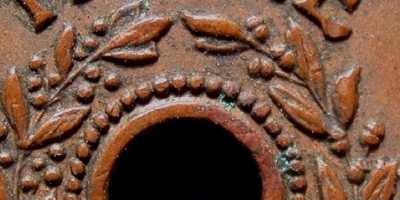
|
|
Some enlargements of portions of the pictures shown above. Note the different leaf
shapes, variations in the number and locaton of the berries in the left branch and
the larger gumnuts in the right branch
|
|
Here we have views of the obverses and reverses of two shilling tokens. Clear differences
can be seen in each. Take note of the different numbers and positions of the berries
in the wreath. The differences are are more noticeable in the left branch on each
face of the coin.
Obverse has 150 rim beads on each coin but on the first coin the inner circle
contains 45 beads whereas on the second coin it contains 44.
The reverses display similar differences. Each coin has 111 rim beads but the
inner circle on coin 1 has 45 beads whereas on coin 2 it has 38.
|
[ Home Page | Australian
coins ]
Visitors: 
Most recent revision: 23rd June 2002
Copyright ©1999, 2000, 2002 Triton Technologies International Ltd, all rights
reserved.


